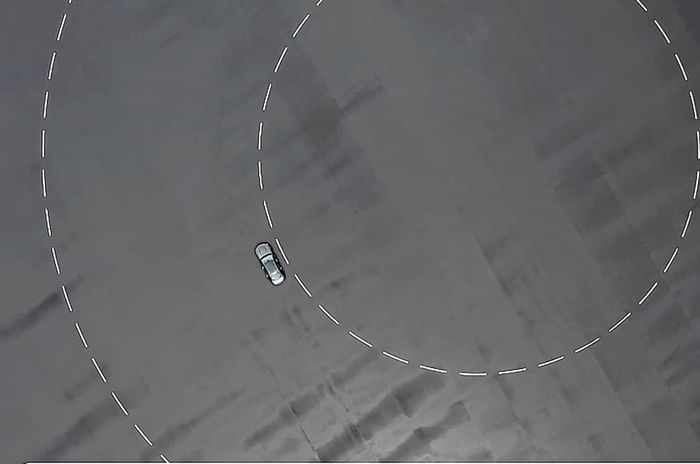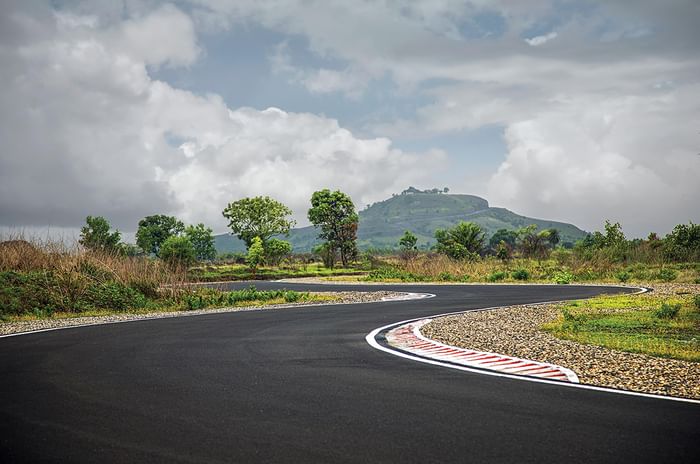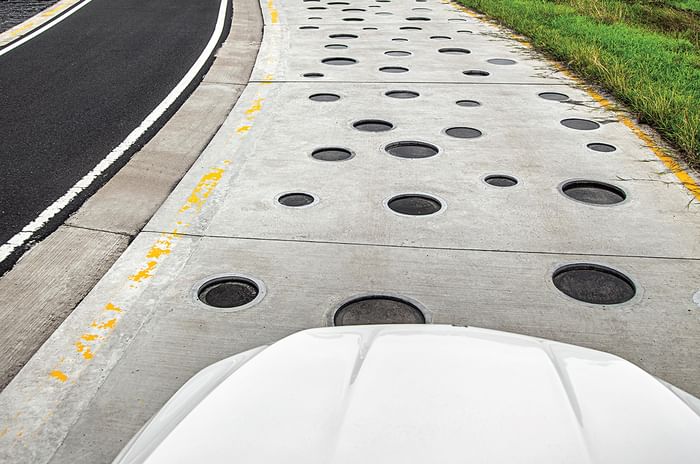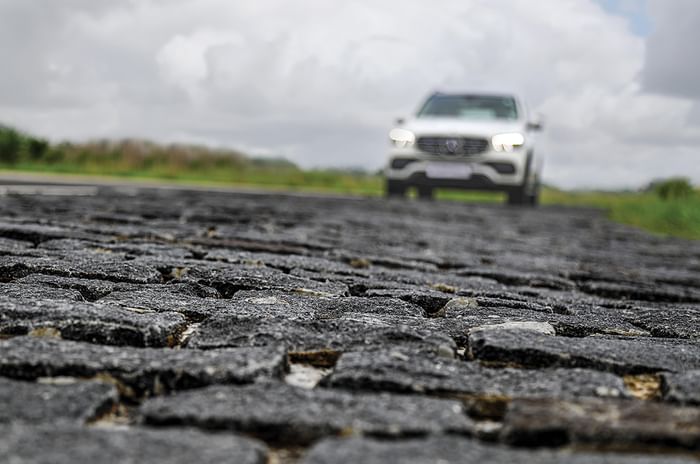Developing a car is a long and arduous process. Yes, modern tools like Computer Aided Engineering and Finite Element Analysis have made the process easier, and with today’s data-driven simulations getting more and more accurate, we are getting closer to the real thing. But there still exists a fair-sized gulf between digital models and the real car; and that primarily is why it’s still imperative to test cars physically.
Here to make the process easier is NATRAX, India’s new testing facility outside Indore in Dhar district, MP, where a whole range of new test tracks have been built. Spread over a massive 2,960 acres, this facility consists of a dozen different tracks and a slew of testing labs. Here are some of the more interesting ones, starting with the newly inaugurated High Speed track.
High Speed Track
11.3km long, four lanes wide and totally flat, the gradient on this track is virtually nonexistent; it deviates no more than plus or minus 3mm from the horizontal. To level the track and build the bankings, the construction team moved 50 lakh cubic metres of earth and 15 lakh cubic metres of rocks. The bankings were built with imported material-transfer vehicles and parabolic sensor pavers that continuously paved the track for a seamless finish and minimum joints. Design speed on the curves, as a result, is a huge 375kph and the transition to and from the parabolic bankings is so gradual, you can’t really pinpoint when you get on or off. It is so good, in fact, you can drive at 250kph with your hands practically off the wheel, with only minor corrections necessary at times. To keep the area safe from outside intrusion, the facility has 23km of fencing.
Built with track specialists IDIADA of Spain as consultants, this facility can be used to carry out various development and homologation tests like coast downs, brake tests, constant-speed fuel-consumption runs, speedometer calibrations, noise & vibration measurements and even long-duration mileage accumulations.
After a big downpour, we even got to experience how good track drainage is. There was no standing water evident during the rain, and the track dried quickly, allowing normal operations to resume without too much delay. This good drainage isn’t by accident; the main drainage canal is placed at a depth of 13 metres and there’s 45 kilometres of reinforced concrete drains, some of them large enough to swim in.
Dynamic Platform

One the largest tracks of its kind in the world, the 300m-wide skid pad is just huge. And it isn’t just the circular track we’re talking of; it even has a 1.5km-long lead in. As a result, all manner of dynamic handling tests can be carried out safely here, with loads and loads of run off area. Constant radius tests, double lane changes, J- Turns and Slalom tests are among the many that can be performed here. To aid consistency, this track even has zero-percent longitudinal slope.
Handling Track

The handling track at NATRAX is the only one of its kind in India. 3.6km long and packed with a variety of corners that mimic those found on regular roads, this track includes sharp curves, flowing bends and even off-camber corners designed to test every facet of a car’s handling. More runoff area would have been nice, but if you are looking for a place to conduct a dynamic evaluation, it doesn’t get much better than this.
Fatigue Track

One of the most important tracks at NATRAX, the fatigue track helps mimic road conditions. Designed to accelerate durability testing of a car this track has got a variety of nasty surfaces like a potholed track, Belgian Pave, large cobblestones and herringbone surfaces that are bad enough to shake the fillings out of your teeth. In all there are a total of 28 different profiles.

Sustainability Track
NATRAX has built a short hill road that it calls the sustainability track. Carmakers can test the cooling performance of an engine, clutch durability and features like hill hold control and hill descent control in near-real-world conditions.
Comfort Track
While the sustainability track is used to evaluate the durability of the car, the comfort track is essential when it comes to tuning the suspension or making fundamental changes that will impact how comfortably a car rides.
The different surfaces include rough concrete, smooth concrete, bridge joints, steps in the road surface, cleats, washboards, and rough asphalt.
Gradient Track

The gradient tracks are used to test the torque and pulling power of a vehicle. You can also test how well it can take off from rest on a slope and just how much traction it has. These tests are done both loaded and unloaded. And then there are patches that also simulate a wet road. Want to get that setting right for your traction control, this is the place to do it. Carmakers even test their Hill Hold functions here. To establish just how capable a vehicle is, a number of individual slopes with differing gradients are used, and cars graduate from one slope to the next.
Also part of the laundry list of test tracks are a wet skid pad, a specialised braking track, a handling track for two and three wheelers and a noise track.
This absolutely world-class proving ground, set in a clean and sprawling expanse is clearly up there when it comes to global standards. A facility that will make future vehicles safer, better engineered and more durable, it is a monumental achievement we all should be proud of and will go a long way in making Indian-engineered vehicles achieve global standards.
Dr N Karuppaiah – Head, National Automotive Test Tracks (NATRAX) Q&A

Your newly opened high-speed track is a marvel of civil engineering. Tell us about the design and engineering behind it.
A test track is basically an open-air laboratory where you have to be able to produce accurate, repeatable results. For this we need to have an even surface. This track on the straight parts has zero degrees of elevation change and the margin for error overall is just plus or minus three millimetres. Then to deliver a smooth transition at very high speeds our bankings are made from asphalt and not concrete.
When it comes to the design of the banking it is important to understand that the tighter the curve, the steeper the angle you need. To get around this, we have used a huge 1,000-metre radius for the curves. I think you must have noticed that in comparison to other proving grounds worldwide, our banking is not that steep, and this makes driving at high speeds more comfortable.
What are the tests one can do here?
You can test max speed, acceleration & fuel consumption very accurately. In addition to that there’s on-centre handling at high speeds, double lane change at speeds as high as 200kph & also high-speed stability and durability. And when I say high-speed durability I mean even at 300kph, as here you can continue running endlessly, without having to slow down on the bankings.
We noticed that drainage is absolutely phenomenal. We had a lot of thunder-showers but there’s absolutely no standing water.
Absolutely. Water is the enemy of asphalt, and we have taken special measures here. There are about four lanes of drainage in total, and the main drain is placed deep and is two metres wide.
Who will be the main users of the track and will it also be open to private owners who want to experience high speeds?
The track is primarily meant for the local OEMs and those who wish to develop vehicles here. This also includes component suppliers and the tyre industry. Now engineers don’t need to go abroad to places like Europe, China, Korea or Taiwan to test. Our facilities in fact are now so good, we can expect some reverse flow of customers, especially as tracks in Europe and other parts close for winter.
Coming to the second part of the question, if after we start taking bookings, we find that we have spare track time, we could invite private customers and supercar owners to experience the thrill of driving at such high speeds. Two things, however, are very important; the safety of drivers and cars and the confidentiality of new vehicles being tested here.
































